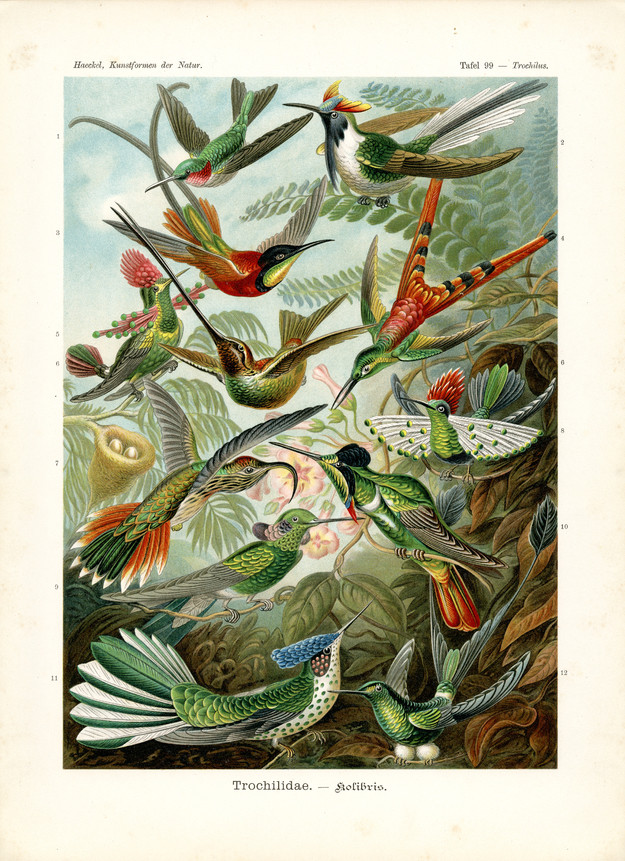Translation of the original German introduction by Ernst Haeckel:
Phylum of Vertebrata (Wirbeltiere); - main class of Gnathostoma (Kiefermäuler); - class of Aves (Vögel); - subclass of Carinatae (Kielvögel); - order of Macrochires (Luftsegler); - family of Trochilidae (Kolibris).
The family of hummingbirds or Trochilidae with more than 400 species is exclusively restricted to America; in the Old World, especially in the tropical regions of Africa, Asia and Australia, it is represented in the family of similar ‘honey-birds’ (Nectariniae). In Europe their closest relatives are ‘sailing swallows’ or swifts (Cypselidae). Among all the birds the hummingbirds are the smallest and tenderest but also, in various respects, the most beautiful and peculiar. Many other bird families, birds of paradise, galliforms, parrots, etc. resemble them in splendour of colouration, metallic shine and beautiful design of the plumage, some may even surpass them.
The most unique aesthetic charm and poetic glorification of the small hummingbirds is bestowed on them with the confluence of its delicate body shape, magnificent feathering and the exceptional grace and velocity of the movements as well as the intimate relation to the equally beautiful flowers that give them life. Names like “flower-birds, flower-kisser, flower-elves, splendour-elves, flower-nymphs, lustre-nymphs” etc. that are used for individual divisions give a poetic expression to the intimate interdependence between hummingbirds and the flowers they visit; on the other hand the magnificent metallic shine of the colourful feathering, imitating the most beautiful precious stones, is expressed in names like: “jewel-birds, diamond-birds, topaz-elves, ruby-nymphs” etc.
Like in most other birds that attract attention with the colourful splendor and beautiful design of their plumage in hummingbirds, too, it is the male that has such ornamental asset; females are usually much more pale and plain in colouration and lack the distinct decoration that males develop on their heads in the form of plumes of feathers, on their legs as ‘feather-knickers’, as the long tail in the form of decorative feathers or fork-tails, etc. Reasons for such sexual differentiation have been revealed with the help of selection theory; it teaches how to understand continued “sexual breed choice” as physiological cause yielding unknowingly the most beautiful “art forms of nature”. The refined aesthetic taste of the sensitive female gives preference to a male that is distinguished from others by the shine and splendor it its plumage; conferring these individual preferences through inheritance to the offspring of the ‘loving pair’, cumulating and enhancing them through repeated sexual selection within successive generations, the admirable beauty of the feathered “art form” comes into being. Just like in human life it is love, all overcoming affection and devotion of the two sexes, inexhaustible source of pure pleasure, of the most beautiful products of the mind, wonderful creations in poetry, music, painting and sculpture, it is in these lovely, small birds the cause of their unsurpassed ornaments. Charming love-play of the tender male hummingbird that precedes the ‘conjugal union’ testifies to this; during these “flying love dances” the courting male does not only reveal the full magnificence of its physical beauty but clutters the selecting female with endearment and attention.
Thus, in respect of significant sexual selection, too, hummingbirds resemble the similarly decorated insects, above all the butterflies which are equally called “flower birds”. As the distinct shape of the butterfly snout is used to plunge the long sucking tongue into the depth of the calyx in order to nibble its honey this equally holds true for the long and slim beak of the hummingbirds and the double-columned tongue concealed in it. The difference is, however, that most hummingbirds not only feed on the honey juice of the flowers, but simultaneously on the small insects (beetles, flies, etc.) that have collected when visiting the depth of the calyx. Many species of hummingbirds are, just like butterflies, bound to visit only one particular species of flower; their delicate taste got so much used to the special ‘honey juice’ secreted by this plant and the distinct insects that come for this delicacy that they despise all other pleasures.
As a consequence, the peculiar shape and length of the fine, sword-shaped beak got adapted to the shape of the calyx. The small feet of these flower birds are used to a very limited extent only, basically to clasp thin twigs while resting; they are therefore almost withered. All the more strongly developed are the small and long wings which are almost continuously in practice. The observer of living hummingbirds is amazed about stamina, agility and velocity of their flight with the bodies in their metallic shine, as swift as an arrow, appearing in the sun light like shot precious stones.
Translation by VR Translators Bangalore
We've scanned the original lithography at 1200dpi on the Epson A3 scanner of A3 scanner huren. You can download a 400dpi JPEG here.
